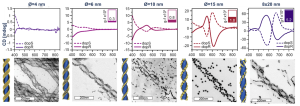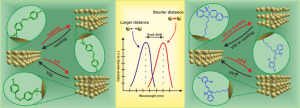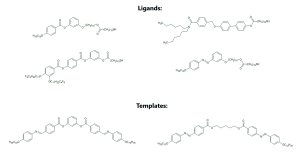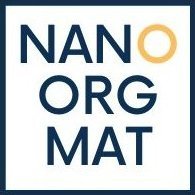Our projects
- Chiral nanomaterials
One of the significant paths we take is the exploration of (nano)material chirality, a property ubiquitous in nature that allows materials to interact selectively with either left- or right-handed circularly polarized light.
We pioneered the creation of thin-film chiral materials relying on the use of liquid crystals forming supramolecular chiral structures, such as helices or nanotubes. The soft character of the liquid crystals facilitates the incorporation of various dopants, such as gold nanoparticles, quantum dots, or perovskites with different sizes and morphologies. Guiding their self-assembly into hierarchical, chiral structures leads to enhanced chiroptical properties across the UV-Vis-NIR spectrum, providing opportunities for chiral sensing, enantioselective catalysis, and advanced photonic applications.
We made significant steps in developing novel synthetic approaches to morphologically chiral gold nanoparticles. We developed novel organic chirality inducers and mastered their colloidal stability and adaptability to different environments. We now explore these nanomaterials in the next generation of biosensors and catalysts.
An exemplary publication resulting from the research conducted by members of our group:
Liquid Crystal Templated Chiral Plasmonic Films with Dynamic Tunability and Moldability D.Grzelak, M. Tupikowska, D. Vila-Liarte, D. Beutel, M. Bagiński, S. Parzyszek, M. Góra, C. Rockstuhl, L. M. Liz-Marzán, W. Lewandowski Adv. Funct. Mater. 2022, 32, 2111280, DOI: 10.1002/adfm.202111280

- Multiresponsive nanoparticles assemblies
The purpose of the Project is to develop and obtain series of new types of liquid crystalline nanomaterials which structure contains synthetic functional molecules (mesogens) and self-organizing nanoparticles including gold, silver or iron oxide. Liquid crystal molecules provide several advantageous properties and their incorporation into nanoparticles can be utilized in the development of nanoscale smart technologies that respond to a specific external stimuli in a controlled manner. Our current efforts seek to further utilize the combination of molecular order (liquid crystalline) and responsiveness to external fields to create novel multi-functional nanomaterials of potential use in photonics and electronics.
An exemplary publication resulting from the research conducted by members of our group:
Gold nanoparticles thin films with thermo-and photoresponsive plasmonic properties realized with liquid-crystalline ligands. E. Tomczyk, A. Promiński, M. Bagiński, E. Górecka, M. Wójcik. Small, 2019, 15,37, 1902807. DOI: 10.1002/smll.201902807

- Biosensors and bioapplications
- Organic synthesis of mesogenic compounds
One of our strengths is the possibility of performing multi-step organic syntheses. Having more than 10-years’experience and well-developed laboratory infrastructure, we are able to obtain a wide range of compounds with diverse molecular structures (e.g. azobenzenes, spiropyrans, polycatenar compounds, dendrimeric compounds, exemplary molecular structures of these compounds are shown in the figure below*).
We particularly focus on liquid crystals showing rich structural polymorphism, which can act as nanoparticle surface ligands, or templates for guiding nanoparticle assembly. Due to liquid-crystalline character of the used compounds as well as presence of various stimuli-sensitive molecular moieties we are able to control self-assembly process by various external stimuli (temperature, UV-VIS, light, pH changes). We have hands-on experience in the analysis of the structure and polymorphism of the synthesized compounds using a variety of techniques (XRD, DSC, POM, TEM, SEM, AFM).
An exemplary publication resulting from the research conducted by members of our group:
Hydrophobic Gold Nanoparticles with Instrinssic Chirality for the Efficient Fabrication of Chiral Plasmonic Nanocomposites. N. Kowalska, F. Bandalewicz, J. Kowalski, S. Gómez-Graña, M. Bagiński, I. Pastoriza-Santos, M. Grzelczak, J. Matraszek, J. Pérez-Juste, W. Lewandowski. ACS Appl. Mater. Interfaces 2022, 14, 44, 50013–50023. DOI: 10.1021/acsami.2c11925

